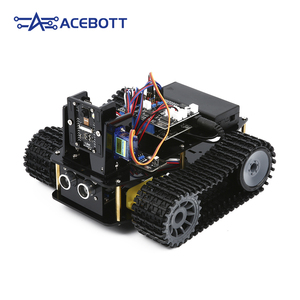
All categories
Featured selections
Trade Assurance
Buyer Central
Help Center
Get the app
Become a supplier

(9392 products available)





















































There are several types of car-related projects that can be done using an Arduino, depending on the type of car and the desired level of complexity.
The telemetry system will give real-time data about the things like speed, tire pressure, and engine temperature.
Analog ultrasonic sensors can be installed on the rear of the car to detect any obstacles in the car's pathway. A small light or speaker can be installed to alert the driver when objects are too close.
This Arduino speedometer project only requires a GPS module. The GPS module is placed on the car to retrieve coordinates continuously. The coordinates will be sent to the Arduino, which will calculate the car's speed and show it on an LCD.
The coordinates on the car will retrieve the GPS Latitude/Longitude, and then the Arduino board will calculate the speed using these coordinates. This project shows how just an hour of free GPS data can be turned into something useful.
This Arduino car speed limiter project will restrict a vehicle's speed. Even if this project is simple, it can improve safety and fuel efficiency and lower maintenance costs. It can also be installed on any vehicle. For this project, an LCD and Bluetooth module are needed to monitor readings.
Many people want to know how to use an Arduino on OBD2 cars. OBD II stands for On-Board Diagnostic, a system made in 1996 to help mechanics retrieve trouble codes even without machine inspection. With this DIY OBD2 scanner, the car's state can be monitored in real-time. Showing on an LCD will turn out to be even more informative.
If people's vehicles have OBD II, they can use this project to get readings without wires by connecting a Wi-Fi shield or module.
This is a great project to test how fast a USB device can transfer data. It can also be a good learning experience.
This system is great since it can help even the most wild remote control car helps with DIY projects.
This project uses a rain sensor and an Arduino board to automatically turn the car's wipers on when it rains. It's great because it helps save on the car's wiper motor and human effort during heavy rain.
Carbon footprint can be reduced by building many commercial applications for cars with Arduinos.
GPS trackers for cars can be made using small gadgets, and such trackers are handy in logistics and transportation. Fleet tracking can be done in different ways, including tracking the position of the vehicles and even the performance of the drivers.
These small plugs can link a vehicle's OBD II port with a mobile application via an Internet connection. Telematic dongles can be used to measure the mileage and provide real-time information on the location and state of the vehicle. They are used in car insurance, logistics, and vehicle surveillance.
These systems link mobile devices to vehicles for remote control capabilities, such as unlocking doors or starting the engine.
Building vehicle-to-everything communication that will allow vehicles to transmit information on speed, traffic conditions, and safety to nearby vehicles and infrastructure to help avoid accidents and minimize traffic jams.
Kill switches and other devices that turn off main parts of cars used in money collection can be built using Arduinos. These devices can suddenly shut down a vehicle based on mobile communications.
Even without any commercial applications for Arduino in cars, several DIY-based projects can still provide a social benefit.
Speed measurements taken with a smartphone will not be perfect because of the disturbance caused by our hands during measurement. This device can be placed on the dash during runs to give accurate speed readings.
Ultrasonic sensors can be installed on the belly of big trucks to detect someone who is in danger of being unnoticed by the driver when driving close to the edge. This can be done by noticing pedestrians or cyclists within the area and sending an alert out.
Propagandist mirrors can be applied to reduce blind area problems in some vehicles. However, these propagandist objects are flawed because they distort image perception. An Arduino construct can give an accurate image of the area behind and beside vehicles, which is better than any convex mirror.
Every year, many people die because they did not wear their seatbelts, and unsafe driving also claims a lot of lives. An Arduino project can be made, which will monitor seatbelt usage and driving style, sending alerts to people who are driving unsafely or are not wearing seatbelts. This can help the person driving a car and, at the same time, reduce road accidents.
In some cases, cars with electronic parts, like the car stereo kit, must go through stress testing and certification, especially for more sensitive Arduin-based projects.
There are various car-related projects that can be done using an Arduino. They include telemetry systems to give real-time data on speed, tire pressure, and engine temperature.
There are ways of connecting an Arduino to vehicles, which are considered safe and successful ways to implement extra gadget-type projects and hardware extensions, making it a popular choice among car and electronics enthusiasts.
For wired connections, use a USB cable to link your phone and car system through an analog USB input jack and power connector. Bluetooth wireless is used to connect phone call and media audio.
Usually, the OBD2 port voltage range is from 8 to 16 volts, with the most frequent one from 12 to 14.5 volts. An Arduino board can work even at 6-20 volts.